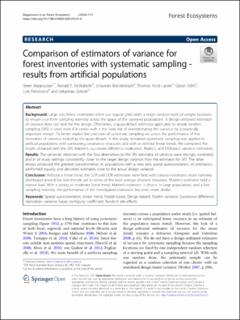| dc.description.abstract | Background: Large area forest inventories often use regular grids (with a single random start) of sample locations to ensure a uniform sampling intensity across the space of the surveyed populations. A design-unbiased estimator of variance does not exist for this design. Oftentimes, a quasi-default estimator applicable to simple random sampling (SRS) is used, even if it carries with it the likely risk of overestimating the variance by a practically important margin. To better exploit the precision of systematic sampling we assess the performance of five estimators of variance, including the quasi default. In this study, simulated systematic sampling was applied to artificial populations with contrasting covariance structures and with or without linear trends. We compared the results obtained with the SRS, Matérn’s, successive difference replication, Ripley’s, and D’Orazio’s variance estimators. Results: The variances obtained with the four alternatives to the SRS estimator of variance were strongly correlated, and in all study settings consistently closer to the target design variance than the estimator for SRS. The latter always produced the greatest overestimation. In populations with a near zero spatial autocorrelation, all estimators, performed equally, and delivered estimates close to the actual design variance. Conclusion: Without a linear trend, the SDR and DOR estimators were best with variance estimates more narrowly distributed around the benchmark; yet in terms of the least average absolute deviation, Matérn’s estimator held a narrow lead. With a strong or moderate linear trend, Matérn’s estimator is choice. In large populations, and a low sampling intensity, the performance of the investigated estimators becomes more similar. Keywords: Spatial autocorrelation, Linear trend, Model based, Design biased, Matérn variance, Successive difference replication variance, Geary contiguity coefficient, Random site effects | en_US |

